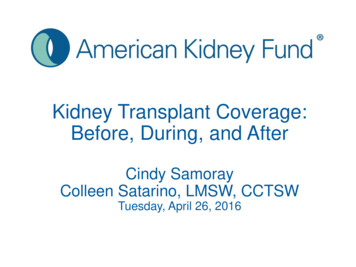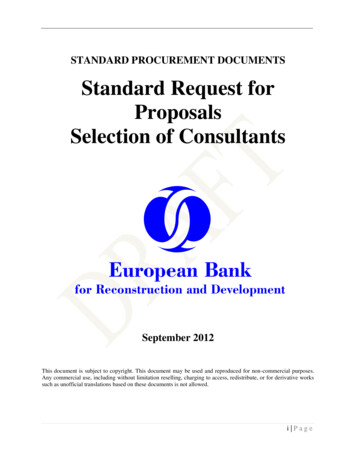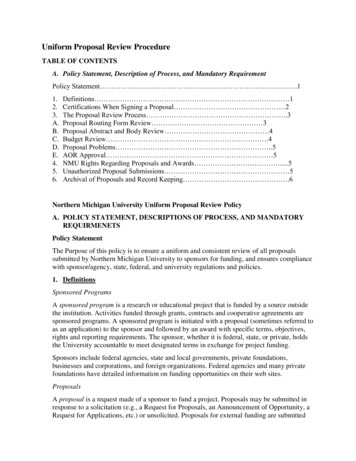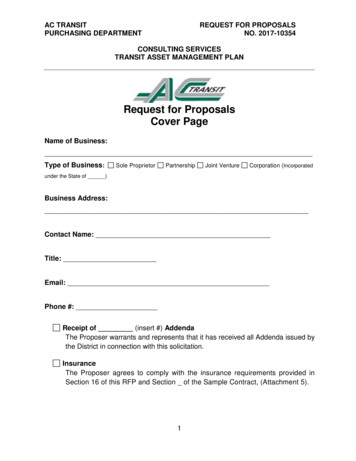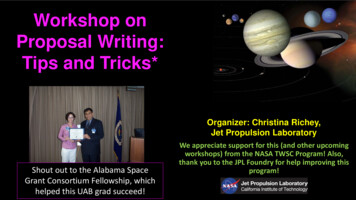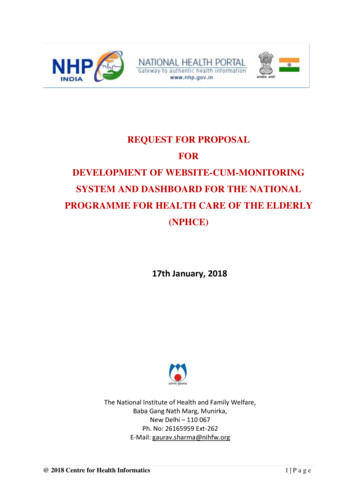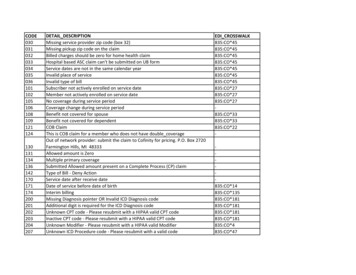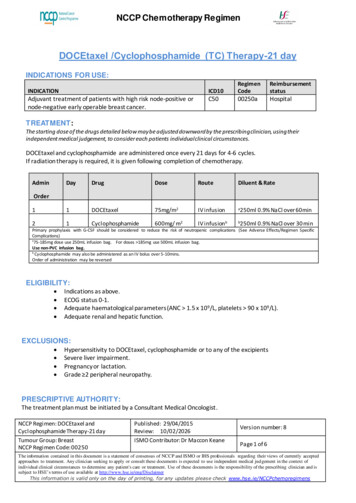
Transcription
From ICD10 to ICD11Proposal for a general approachand incorporationpof rarediseasesSégolène Aymé,COMP meeting -1 April 2009
ICD Revisions965401,0401,1664ICD 7ICD 8ICD 9200ICD 5954214189ICD 2ICD 4179ICD 1205161BeertillonICD 3139Farr/d'EEspine1000ICD 61000014,4731,99678,17310000010010D-10-MICDICD 10ICCD-9-M11853 1893 1900 1909 1920 1929 1938 1948 1955 1968 1975 1979 1993 1993CLASSIFICATIONS BUILDING BLOCKS OF HEALTHINFORMATION
ICD-10 Revision organization structureKMSFIELD TRRIALSWHOWHO FICUpdate & RevisionCommitteeRevisionSteering GroupTopical AdvisoryGroup:Topical AdvisoryGroup:Topical AdvisoryGroup:Topical AdvisoryGroup:Topical AdvisoryGroup:Topical AdvisoryGroup:Mental HealthExternal CausesNNOncologyInternal MedicineRare RTAL
The Revision Steering GroupChair of the RSGChristopher G ChuteMayo ClinicRochester USARochester,
The Revision Steering GroupRare DiseasesChair: Ségolène AyméO h tOrphanetRare Diseases PlatformBroussais Hospital, Paris, France
Role of TAG Advise WHO in all steps leading to the revision Establish workgroups and partners to involve––––Generation of necessary evidenceDevelop proposals for changesEstablish proceduresFacilitate cross fertilization of ideas and reducingredundant efforts Advise in developing various drafts of topicsegments in line with the overall productiontimeline of ICD11 Advise in developing protocols for and inimplementing field trials
Composition of TAG Rare Diseases Europe:p– Ségolène Aymé, Ana Rath (Orphanet) USA:– Stephen Groft,Groft Roberta Pagon (Office of RDRD-NIH)NIH) Korea:– Hyun-Young Park (CDC-Information Center, Seoul) Brazil:– Eduardo Castilla Argentina:– Monica Rittler Mexico:– Osvaldo Mutchinick Russia:– Evgeny Ginter China:– Yiming Wang
Experts for peer-reviewpeer review Experts identified by Orphanet– Editorial board members– OrphanetO ht scientifici tifi advisoryd ibboardd attcountry level– European networks / Learned societies Same process in each region– Decided by each TAG member
ICD--10 PlusICDApplicationICD-10 WEB Application Clinical Modification Ownersenter their CM version CodesKeyy TasksAAccess TAG andd WorkgroupsW kentertproposals ANY USER can POSTproposals or comments. ANY USER can REVIEWother proposals and discuss.ICD-10 TechnicalTh i lLayer- Proposals- Comments- Discussions- EvidenceICD--11 draftICDHi KiHi-KiJoint-authoring ToolWIKI like application TAG Experts for ICD-11 WHO editors Taxonomic rules Definitions Diagnostic criteria ALL USERS can seedrafts and comment.ICDTerminologyProtégé/OWLLEXGRID Ontology Model Linkages between ICD and:- SNOMED- Other ontology & terminologies Clinical interface algorithms ALL USERS can seedrafts and commentICD-11ICD Ontology- Comments- Discussions- Evidence- Entities- Attributes- Linkages
Change Proposal Generation Implicit creation of change proposalby changing local view Can be extracted into machinableformat Editors and reviewers can seechangesg in context– What would it look like if adopted UserUcan writeit explicitli it proposall
Hierarchy of Hiki Authorityb ICD DbyDomaini0 Revision Steering Committee1 Revision Domain/Topic WorkingGroups2 Accredited Experts– Designated by Working GroupMembers3 Accredited Persons– Designated by Experts4 Registered Interested Persons(Public)
Tentative Timeline 2010 : Alpha version ( ICD 10 Æ ICD11draft)– 1 YR : Commentaries and consultations 2011 : Beta version & Field Trials Version– 20 2 YR : Field trials 2013: FinalFi l versioni forf publicbli viewingi i– 2014 : WHA Approval 2015 implementation
Preparatory work at OrphanetStep 1: collect published classificationsand build a clinical oneSiSince2006
Classification of rare diseases Methodology:– Collection of published classifications of specific groups of rarediseasesdi Clinical classifications By mechanism or by aetiology– Building up of a comprehensive classification of Orphanetentries to serve the needs of Health Care information systems:the Orphanet classification of rare diseases BasedBd on– Literature (reference texts, scientific publications)– Experts working groups Validated by the scientific advisory board of Orphanet Regularly updated
Rationale for a clinicalclassification– Criterion: medical/surgical specialties involved in themanagement of the different manifestations of adisease– StickSti k tto medicaldi l specialtiesi lti organisedi dbby system,tththenby group of age (pediatrics/adults), then bysubspecialty (i.e.(i e epileptology)– Etiological/physiopathological criteria were futherapplied, when relevant for diagnosis/management
EpidemiologicalpgData:ClassificationsClinical signsg(OrphanetControlledVocabulary)PrevalenceAge of onsetAge of deathMode ofinheritanceRareDiseaseORPHAnumberICD-10OMIM numberGenesGeesP bM d queryPubMedM SH dMeSHdescriptorsi t
Orpha nomenclature Comprehensive list of rare diseases ( 5,850)– Identity card genes– Unique Orpha number Stable what ever is the evolution of knowledge Linked to parent and child disease in every classification– Files available on request for use in information systems For research purpose At running cost for non-profit use Material TransferAgreement Classifications of rare diseases (by September 08)– List of all published classifications– Visualisation of each classification– Possibility to click at any level to have the detailedinformation
Preparatory work at OrphanetStep 2: Analyse ICD10 and identifyproblemsSiSince2007
Identification of coding difficulties Preliminary study on ICD-10 coding forrare diseases– Identification of specific codes: 240 ONLY– Identification of rare diseases listed under acategory– Cross-matchingCt hi withith otherth ddatasetstt (CINEAS(CINEAS,UKGTN, Veneto register)– Typology of problems for coding rarediseases with ICD-10
Matching incorrectspecificpcodes Marfan syndrome– Q87.4Q87 4 In: Q87 Other specified congenital malformationsyndromesdaffectingff ti multiplelti l systemstCould have been included in– M30-M36M30 M36 Systemic connective tissuedisorders
Problematic groupsof diseases Skin diseases– Some skin diseases are coded as malformations Q80 Congenital ichthyosisQ81 Epidermolysis bullosaQ82 1 Xeroderma pigmentosumQ82.1etc.
CodingCdi accordingdi totthe cause or the consequence? AlkaptonuriapE70.2 Tyrosinemia type 1 E70.2– E 70.2: Disorders of tyrosine metabolism AlkaptonuriaAlk ti Tyrosinemia – Both diseases are coded to the cause but phenotypes are quite different Alkaptonuria: pigmentation disorders, muscular-skeletal symptoms,arthropathy or asymptomatic Tyrosinemia: severe hepatocellular necrosis (early onset form),renal tubulopathy (late onset form)
How to codehereditaryy forms of diseases? Melanoma, familial C43 Melanoma, malignant– A Z80 code should be added to familial formsof cancers? WhWhatt aboutb t ffamilialili l fforms off nott rarediseases?– Parkinson disease, familial form GG200 Parkinsonaso ddiseasesease
First conclusions Lack of systematic approach– Classification according to major symptom– Classification according to etiology / mechanism Confusion between anatomyy / organsgandSystemsRespiratory system,system cardiovascular systemsystem,immunological system ConfusionC f i bbetweent« malformationlfti » andd« congenital » and « genetic »
Preparatory work at OrphanetStep 3: Contribute to ICD10 and ICD11Since January 2009
Process at Orphanet ChapterCh t bby chapterh t comparisonibbetweent– ICD-10– Orphanet classification– Published classifications ((when available)) List of proposals for ICD-10 Proposal for ICDICD-1111 for the chapter– An information scientist was recruited to assistsubmittingb itti proposalsl ((contractt t RDTFsecretariat 2009-2011)
ICD10 proposals Each proposal is– qualified following the WHO revision tool– justified (literature) Orphanet input on the ICD10 revision– based on already validated subclassifications Experts for the specialty ( Official networks/ Societies / Associations))– informed in order to add their contributions tothe revision process
ICD 11 proposalsICD-11 Addossieri withith ththe rationaletil ffor proposalslis established The definitional items chart (WHO) isfullfilled for each disease The dossier is submitted– to identified best experts by Orphanet and byNIH A final proposal will be sent to WHOWHO,chapter by chapter, one every month
Proposal for general principlesBased on published classificationsand on past experience in usingcodes at Orphanet
Rare diseases andbiological systems Biological systems are networks– Hierarchyy of networks– Higher nodes are limited in numbers :Minorityof nodes account for a large amount ofconnections: Metabolic,Metabolic signalling,signalling immunityimmunity, repairrepair, stressstress .– Common Diseases: extreme values at oneupper node– Rare Diseases: extreme values at lowernodesd
Organisation of Chapters By system– based on physiology– Etiology/mechanism being the final level– From the « upper level » to the « lower level » Addition of a chapter for mutisystemic diseases– Ex: Marfan syndromeyis a multisystemicydisease Chapter for prenatal developmental defects (notonly malformation) as in utero development is aprocess- a « system »)
Conclusions Possibility to propose a profound evolution of theorganisation of chapters II to XVIII– With a possible migration of almost all existing codes– With a common logics applied to all chapters– Putting rare diseases where they should be Everywhere as a lower node Chapter on Haematology is already availableand under review by experts Production of one chapter per month– Endocrinology (April), Immunology (May) .
Experts for peerExperts for peer-review Experts identified by OrphanetExperts identified by Orphanet - Editorial board members - O h t i tifi d i b d tOrphanet scientific advisory board at country level - European networks / Learned societies Same process in each regionSame process in each region - Decided by each TAG member
